Winter 2013
Villanova i la Geltru
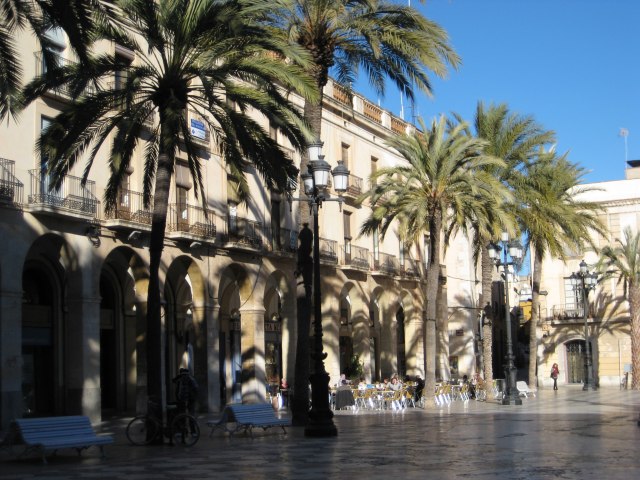 Villanova i la Geltru
The passage from Mallorca to Vilanova i la Geltru on the Spanish mainland went smoothly. We departed at 13:00 on the 21st November and arrived the following morning. Most of the time we had a calm sea and light following winds though not enough to make good headway under sail alone, so we motor sailed. A few hours into the passage we were visited by a robin redbreast which fluttered into the cockpit, perched on the steering wheel, eyed me suspiciously, stayed for a few minutes, then flew off again. I think we were going in the wrong direction! Over night, the waning gibbous moon (86%) cast a pleasant glow even when we were under cloud and for the time of year it was unusually warm. We had many radar contacts during the night and Tan did a great job on watch from 23:00 to 03:30 at which time I had to pry her from the wheel. We made exceptionally good time so around 05:30 with just eight miles to go I slowed down to arrive in daylight and office hours. At 08:50 we made landfall at Club Nautic Vilanova.
Villanova i la Geltru
The passage from Mallorca to Vilanova i la Geltru on the Spanish mainland went smoothly. We departed at 13:00 on the 21st November and arrived the following morning. Most of the time we had a calm sea and light following winds though not enough to make good headway under sail alone, so we motor sailed. A few hours into the passage we were visited by a robin redbreast which fluttered into the cockpit, perched on the steering wheel, eyed me suspiciously, stayed for a few minutes, then flew off again. I think we were going in the wrong direction! Over night, the waning gibbous moon (86%) cast a pleasant glow even when we were under cloud and for the time of year it was unusually warm. We had many radar contacts during the night and Tan did a great job on watch from 23:00 to 03:30 at which time I had to pry her from the wheel. We made exceptionally good time so around 05:30 with just eight miles to go I slowed down to arrive in daylight and office hours. At 08:50 we made landfall at Club Nautic Vilanova.
Vilanova is the capital of El Garraf, a region which lies half-way between the main metropolitan areas of Barcelona (40 km to the North East), and Tarragona (45 km to the South West), and covers a total area of 33.5 square km. According to the 2012 census it has a population of 66,591 inhabitants. Its rich history dates back many centuries; in 1274 it was awarded the Carta Pobla (City Charter) by King Jaume I. Today the city is a well balanced mixture of tourism, agriculture, fishing, and industry so it stays "open" all year unlike many tourist centric places which die in the winter. The main language is Catalan, amost all menus are in Catalan only, although we get by with Castillano. Very few people speak English!
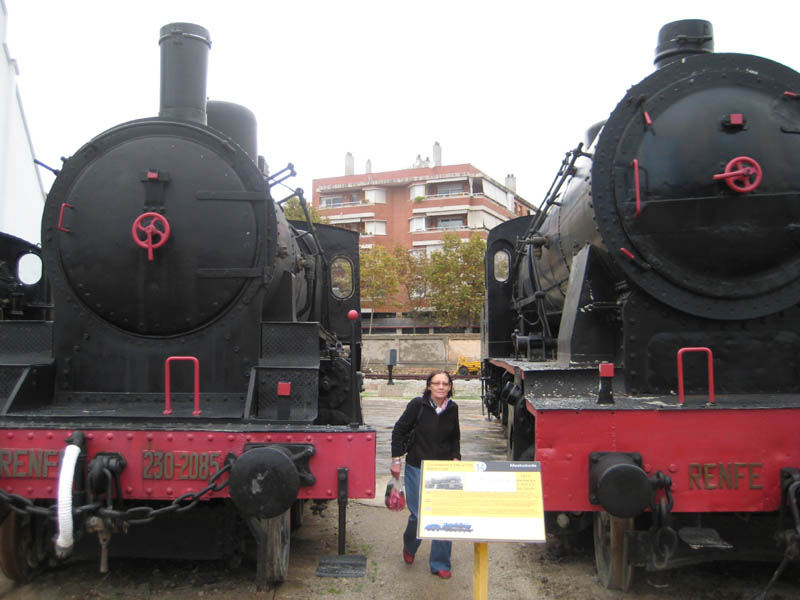 Vilanova Railway Museum
The city also has its own bus service which is cheap and efficient (7.35 euro for 10 journeys). You need a degree in logic to understand it but once mastered itīs simplicity itself. There are four bus routes L1 to L4 which are all clearly marked in diferent colours on the bus map together with all the stops. Once you solve that L1 goes from A to B but never comes back its simple. So where does this endless supply of L1 busses come from? When an L1 bus gets to B it morphs into an L2 and goes back to A (clear so far?) thats because the return route isnīt quite the same as the outward journey due to one way streets and deviations. Once back at A it morps into an L1 again. The same logic applies to L3 and L4.
Vilanova Railway Museum
The city also has its own bus service which is cheap and efficient (7.35 euro for 10 journeys). You need a degree in logic to understand it but once mastered itīs simplicity itself. There are four bus routes L1 to L4 which are all clearly marked in diferent colours on the bus map together with all the stops. Once you solve that L1 goes from A to B but never comes back its simple. So where does this endless supply of L1 busses come from? When an L1 bus gets to B it morphs into an L2 and goes back to A (clear so far?) thats because the return route isnīt quite the same as the outward journey due to one way streets and deviations. Once back at A it morps into an L1 again. The same logic applies to L3 and L4.
Although quite large with over 950 moorings Club Nautic Vilanova is well laid out and has a nice feel. It is only a few minutes walk to the main entrance and a few more to the bottom of the Rambla (the main pedestrian strret). Club Nautic shares a large harbour with a super-yacht marina, a fishing fleet, a lifeboat station and a commercial port. Once the formalities and things that must be done on arrival at a new port after an overnight passage (such as secure mooring lines, water and electricity connections etc.) the fatigue sets in for a couple of days. After that its time to explore.
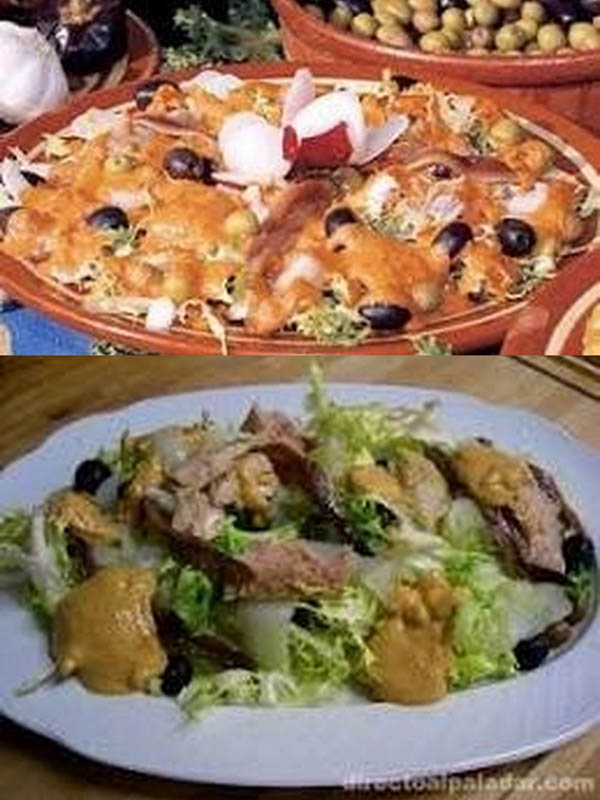 Xato
Vilanova has an excellent tourist information office with convenient opening hours and staffed by the knowledgeable and very helpful Natalia. High on Tans list is launderettes and laundries. The marina has a machine but it´s broken and won't be fixed until spring. The tourist information office computer printed a list which I cross-referenced against Google maps then the leg work began. There is only one self service launderette which is a bit tacky but we found a reasonable laundry service nearby. There are two local markets and numerous supermarkets including three Mercadona, several Condis, two BonArea and a Caprabo all within easy cycling distance. There is also a Next, Punt Roma and several other up-market shops.
Xato
Vilanova has an excellent tourist information office with convenient opening hours and staffed by the knowledgeable and very helpful Natalia. High on Tans list is launderettes and laundries. The marina has a machine but it´s broken and won't be fixed until spring. The tourist information office computer printed a list which I cross-referenced against Google maps then the leg work began. There is only one self service launderette which is a bit tacky but we found a reasonable laundry service nearby. There are two local markets and numerous supermarkets including three Mercadona, several Condis, two BonArea and a Caprabo all within easy cycling distance. There is also a Next, Punt Roma and several other up-market shops.
The weather through to mid-November was warm and sunny then it broke in style: cloud, rain, wind and thunderstorms. Sunday the 17th was relatively dry so we took the opportunity of free entry into the
 Museu del Ferrocarril de Catalunya
(Railway Museum) and we were both pleasantly surprised. It is located in what used to be (until 1967) the old steam engines depot most of which dates back to the 19th century. At the centre a large electrically operated turntable radiates 33 railway lines outwards some of which lead to the impressive semicircular rotunda building where most of the steam locomotives are preserved. The museum has more than 80 engines of all classes: electric, diesel, and steam dating from 1848 as well as rolling stock and carriages. With 28 steam engines, the museum boasts the most powerful engine of its time in Europe and the last steam engine to run in Spain. There are also three water towers and a signal gantry.
Museu del Ferrocarril de Catalunya
(Railway Museum) and we were both pleasantly surprised. It is located in what used to be (until 1967) the old steam engines depot most of which dates back to the 19th century. At the centre a large electrically operated turntable radiates 33 railway lines outwards some of which lead to the impressive semicircular rotunda building where most of the steam locomotives are preserved. The museum has more than 80 engines of all classes: electric, diesel, and steam dating from 1848 as well as rolling stock and carriages. With 28 steam engines, the museum boasts the most powerful engine of its time in Europe and the last steam engine to run in Spain. There are also three water towers and a signal gantry.
After leaving the museum we decided to have a menu-del-dia. I had previously noticed a nice looking restaurant called  La Llossa not far away offering a menu complete with wine for 9 Euro. Their Sunday menu was 14 Euro and worth every cent. The place is congenial, the menu comprehensive, the service excellent and the food very good. There was also some nice additional touches, like a small vermut (local) and tapas almost as soon as your bum hit the seat. Since we arrived in Vilanova we have tried two other menus which on the "would you go back" rating scored unlikely, but La Llossa is a definite yes.
La Llossa not far away offering a menu complete with wine for 9 Euro. Their Sunday menu was 14 Euro and worth every cent. The place is congenial, the menu comprehensive, the service excellent and the food very good. There was also some nice additional touches, like a small vermut (local) and tapas almost as soon as your bum hit the seat. Since we arrived in Vilanova we have tried two other menus which on the "would you go back" rating scored unlikely, but La Llossa is a definite yes.
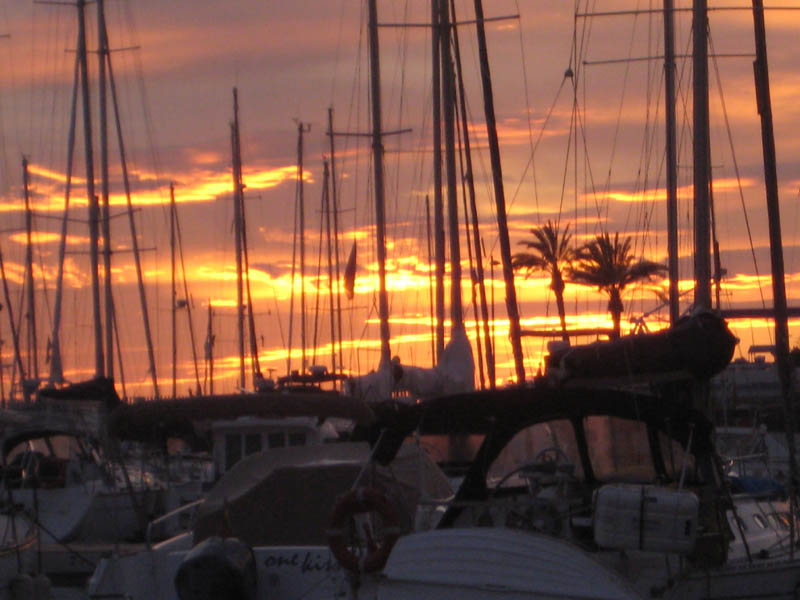 Sunset at the marina
Vilanova is also famous for its gastronomy, Xatò (pronounced shato) being the most celebrated. Its an endive salad with raw cod, tuna, anchovies and olives, and served with a dressing made from toasted almonds and hazelnuts, garlic, olive oil, breadcrumbs, vinegar and Ñora pulp (a type of dried red pepper). On Sunday the 24th November we went to the Xatò Festival held in the Main Market Hall. All the stalls were selling various tapas, cava and wine and you could buy tickets for a plate of Xatò. Unfortunately it was packed to the gunwales and I get very uncomfortable when hemmed in by a crowd so after a few minutes I waited outside for Tan. There were also stalls outside the market and we found a very traditional one selling vegetables where we had a couple of very nice tapas for one Euro each! One tapa was made from Espigalls, which resemble giant elongated dandelion leaves and had been sauteed with white beans, garlic and onion. Espigalls are one of several indigenous vegetables of the area. Espigalls and brotons are leaves that sprout from the flower of a cabbage, whilst Paperina is a variety of savoy cabbage and Perruqueta escarle or cabell d´àangel is a tender and sweet lettuce. Being slightly disappointed by the Xatò Festival because of the crowd we went to La Lossa for a menu-del-dia which was excellent. We both started with a salad of Erizo del mar (sea urchins) which was delicious, Tan followed with beef and mushrooms and I had a piece of cod with a sauce on top which had been baked in the oven until browned to form a delicate crust. It was superb.
Sunset at the marina
Vilanova is also famous for its gastronomy, Xatò (pronounced shato) being the most celebrated. Its an endive salad with raw cod, tuna, anchovies and olives, and served with a dressing made from toasted almonds and hazelnuts, garlic, olive oil, breadcrumbs, vinegar and Ñora pulp (a type of dried red pepper). On Sunday the 24th November we went to the Xatò Festival held in the Main Market Hall. All the stalls were selling various tapas, cava and wine and you could buy tickets for a plate of Xatò. Unfortunately it was packed to the gunwales and I get very uncomfortable when hemmed in by a crowd so after a few minutes I waited outside for Tan. There were also stalls outside the market and we found a very traditional one selling vegetables where we had a couple of very nice tapas for one Euro each! One tapa was made from Espigalls, which resemble giant elongated dandelion leaves and had been sauteed with white beans, garlic and onion. Espigalls are one of several indigenous vegetables of the area. Espigalls and brotons are leaves that sprout from the flower of a cabbage, whilst Paperina is a variety of savoy cabbage and Perruqueta escarle or cabell d´àangel is a tender and sweet lettuce. Being slightly disappointed by the Xatò Festival because of the crowd we went to La Lossa for a menu-del-dia which was excellent. We both started with a salad of Erizo del mar (sea urchins) which was delicious, Tan followed with beef and mushrooms and I had a piece of cod with a sauce on top which had been baked in the oven until browned to form a delicate crust. It was superb.
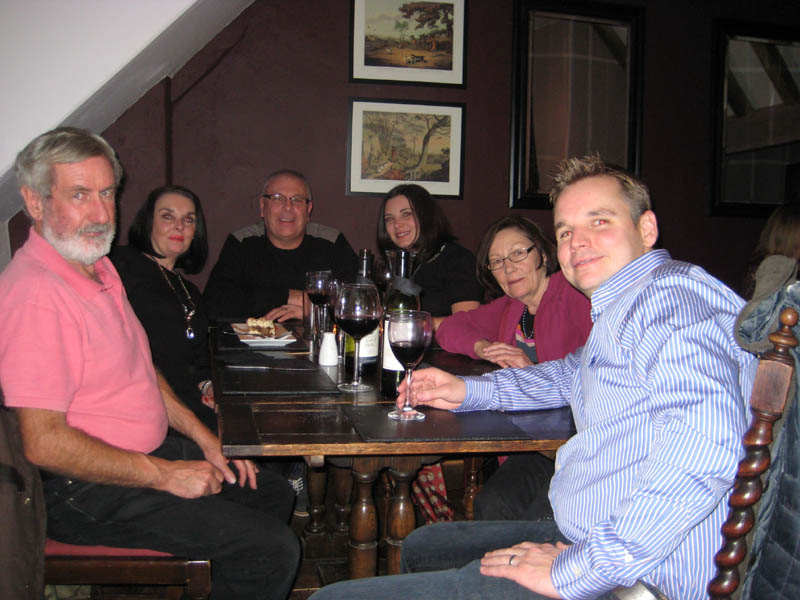 The Myddleton Grill on the Square
Our bright orange flower power bicycle bought about 3 years ago in Alcampo Barcelona for a mere 100€ started playing up a couple of weeks ago. It felt like cycling uphill through treacle! Then we had a puncture in the back wheel, after attempting to fix it 3 times we still had a puncture so I bought a new inner tube! While replacing it I noticed that the wheel bearings were kaput - the axle wobbled alarmingly so we decided to buy a new bike. Armed with research from the Internet I took the train and bus to a massive Alcampo on the outskirts of Barcelona but no joy, next was a bus trip south to a Carrefour, still nothing, finally a whole day trip to Barcelona to recce all the big stores. I finally found what we were looking for at Carrefour for 139€ complete with dynamo, lights, mudguard, chain-guard and luggage rack so I cycled back to the station and brought it back to the boat. Then I bought a new wheel and tyre (28€ and 10€) for the old bike so now we have two good working bicycles.
The Myddleton Grill on the Square
Our bright orange flower power bicycle bought about 3 years ago in Alcampo Barcelona for a mere 100€ started playing up a couple of weeks ago. It felt like cycling uphill through treacle! Then we had a puncture in the back wheel, after attempting to fix it 3 times we still had a puncture so I bought a new inner tube! While replacing it I noticed that the wheel bearings were kaput - the axle wobbled alarmingly so we decided to buy a new bike. Armed with research from the Internet I took the train and bus to a massive Alcampo on the outskirts of Barcelona but no joy, next was a bus trip south to a Carrefour, still nothing, finally a whole day trip to Barcelona to recce all the big stores. I finally found what we were looking for at Carrefour for 139€ complete with dynamo, lights, mudguard, chain-guard and luggage rack so I cycled back to the station and brought it back to the boat. Then I bought a new wheel and tyre (28€ and 10€) for the old bike so now we have two good working bicycles.
December was not a good month. Tan caught some kind of virus which left her continually tired and aching. It lingered for a couple of weeks going through different stages of sneezing, hot and cold flushes, coughing and sleepless nights. When she appeared to be getting better she fainted whilst standing at the sink and collapsed heavily on the floor. A couple of days later she fell from the top of the gangway to the bottom hurting her foot.
Wales
Despite all this, we managed to get to Ruthin in Wales to spent Christmas with Glyn and Emma. We took a taxi from the marina to the station but as soon as we left the marina we were stopped by the Guadia Civil who wanted to see our passports. Nevertheless we got to the station in time for the bus to the airport. Tan had an agonising walk through terminal 2 in Barcelona until we found a baggage trolley and sat her on it for the rest of the journey. Emma´s parents, Alan and Caroline, kindly collected us from Manchester airport.
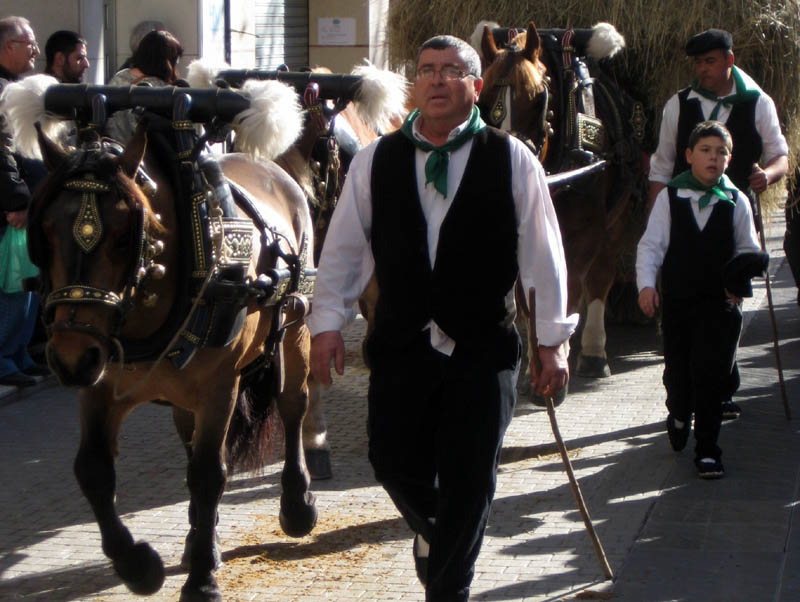 Fiesta de Sant Antoni Abat
Christmas was all it should be, relaxed, slightly indulgent, and in good company. Glyn is an excellent cook and together with Emma they had planned the festive season well, most shopping having been done on-line in advance and delivered at the appointed time. We also spent some interesting time with Derek who Tan usually stays with when in Ruthin and who generously loans Tan a car. We took Glyn, Emma, Alan and Carolyn out to dinner at The Myddelton Grill on the Square on our last night in Ruthin. We had a very good meal from their comprehensive menu in relaxed surroundings. The only shock is the price of wine in the UK, it´s expensive in the supermarkets and outrageous in restaurants.
The return trip to Vilanova went well, I´d booked assistance for Tan via the airline so she was sat in a wheel chail and was whisked through security, customs, to the gate where we were ushered on board prior to general bording (almost as good as 1st class!). There was also a wheelchair waiting for her at Barcelona and the assistant took us all the way through the airport to the railway station. Excellent service.
Fiesta de Sant Antoni Abat
Christmas was all it should be, relaxed, slightly indulgent, and in good company. Glyn is an excellent cook and together with Emma they had planned the festive season well, most shopping having been done on-line in advance and delivered at the appointed time. We also spent some interesting time with Derek who Tan usually stays with when in Ruthin and who generously loans Tan a car. We took Glyn, Emma, Alan and Carolyn out to dinner at The Myddelton Grill on the Square on our last night in Ruthin. We had a very good meal from their comprehensive menu in relaxed surroundings. The only shock is the price of wine in the UK, it´s expensive in the supermarkets and outrageous in restaurants.
The return trip to Vilanova went well, I´d booked assistance for Tan via the airline so she was sat in a wheel chail and was whisked through security, customs, to the gate where we were ushered on board prior to general bording (almost as good as 1st class!). There was also a wheelchair waiting for her at Barcelona and the assistant took us all the way through the airport to the railway station. Excellent service.
Villanova i la Geltru
January is luxury cava month with the Three Kings celebration and with birthday toasts to Glyn, Tan, and Rachel. The rest of the time we drink boat cava (cheaper) but I found an exceptionally nice one reduced from 5.95€ to 2.75€ so every available space on the boat has cava in it.
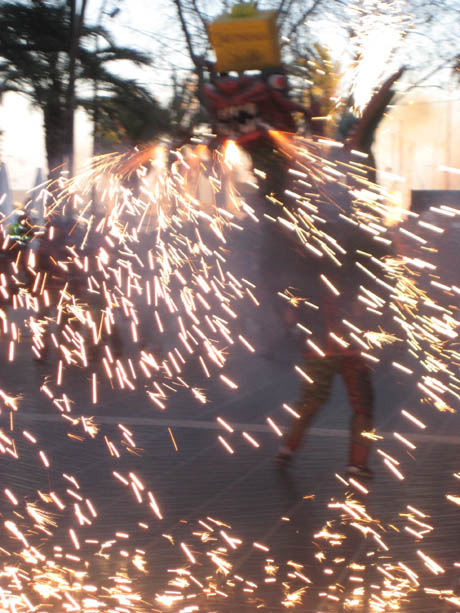 Arrival of the carnival king
The clouds departed and the weather was sunny and warm on the 17th January for the
Arrival of the carnival king
The clouds departed and the weather was sunny and warm on the 17th January for the
 Fiesta de Sant Antoni Abat , Dels Tres Tombs the patron saint of Vilanova. It´s a big local fiesta with a huge procession of carts, drays, and carriages drawn by horses, mules, or donkeys to celebrate the important work done by these animals. Spectators, several deep, lined the route to see the large variety of entrants. Everything from splendid passenger carriages drawn by a teams of two, four or six horses through heavy draught-horses hauling large loads to tiny one person carts with a Shetland or miniature pony between the shafts. We decided to make a day of it and had a menu-del-dia at a nearby taverna. After lunch the crowd had gone but several entrants were still in line for their cups so we had a really good view. Like many Spanish festivals it is more than a one day event and this particular one is from the 8th to the 18th January and the 1st and 2nd February so it was that I came across another procession next day on my way to the launderette. This one was for young dancers. There were several teams spread along the route and let by the Dracs (dragons). These were energetic youths, one of which had a helmet with a spike that accommodated a firework similar to a catherine wheel. It spewed out fire as it span and ended with a resounding bang, quite spectacular. I couldn´t linger long, I had chores to do!
Fiesta de Sant Antoni Abat , Dels Tres Tombs the patron saint of Vilanova. It´s a big local fiesta with a huge procession of carts, drays, and carriages drawn by horses, mules, or donkeys to celebrate the important work done by these animals. Spectators, several deep, lined the route to see the large variety of entrants. Everything from splendid passenger carriages drawn by a teams of two, four or six horses through heavy draught-horses hauling large loads to tiny one person carts with a Shetland or miniature pony between the shafts. We decided to make a day of it and had a menu-del-dia at a nearby taverna. After lunch the crowd had gone but several entrants were still in line for their cups so we had a really good view. Like many Spanish festivals it is more than a one day event and this particular one is from the 8th to the 18th January and the 1st and 2nd February so it was that I came across another procession next day on my way to the launderette. This one was for young dancers. There were several teams spread along the route and let by the Dracs (dragons). These were energetic youths, one of which had a helmet with a spike that accommodated a firework similar to a catherine wheel. It spewed out fire as it span and ended with a resounding bang, quite spectacular. I couldn´t linger long, I had chores to do!
Tan left for Malaga to see her daughter and granddaughters on the 6th February or a week. Just before we left Mallorca last year, the hot water boiler developed a leak (it is 10 years old) but I deferred buying a new one until we got back to the mainland because it meant disconnecting the diesel engine cooling system which would have left us stranded if there were problems. The new boiler arrived in time for me to install it while Tan was away. It took a whole day to disconnect, drain and remove the old one and another day to install and connect the fresh water supplies. I took the third day odd because it was my Birthday and I needed to let the aches subside. I went to La Llossa for a very good menu-del-dia then on a long bike ride. On the fourth day I connected the engine cooling system and tested it. Finally the job was done.
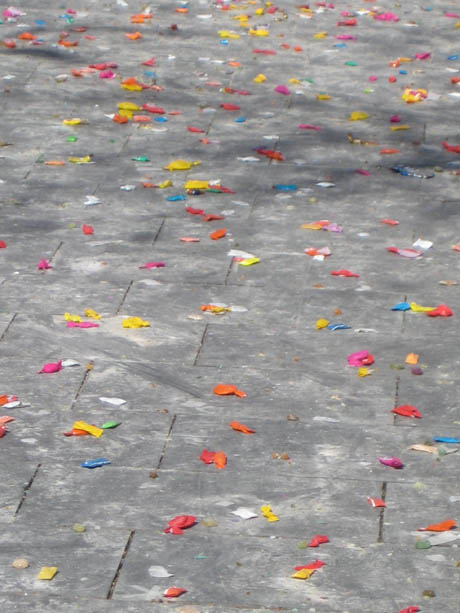 After the candy throwing
Vilanova is renown for it´s
After the candy throwing
Vilanova is renown for it´s  Carnival , which this year was from the 22nd February to the 8th March. The two main events on the 27th (Fat Thursday) are merengada for children and merengada for adults. The merengarda is a meringue war where participants throw meringues at each other. Fortunately I missed it otherwise I would have been tempted to eat them all. On the 28th it was the Arrival of the carnival king. A huge parade with floats satirically inspired by local events and politics. At the head of the parade are the dragon dancers with their wiz-bang fireworks spewing sparks in great circles followed by a tremendous bang. At a safe distance came the king in a horse drawn cart followed by the floats. There were at least sixty, each with its own loud sound system and costumed dancers. It took two 2 hours for them all to pass.
Carnival , which this year was from the 22nd February to the 8th March. The two main events on the 27th (Fat Thursday) are merengada for children and merengada for adults. The merengarda is a meringue war where participants throw meringues at each other. Fortunately I missed it otherwise I would have been tempted to eat them all. On the 28th it was the Arrival of the carnival king. A huge parade with floats satirically inspired by local events and politics. At the head of the parade are the dragon dancers with their wiz-bang fireworks spewing sparks in great circles followed by a tremendous bang. At a safe distance came the king in a horse drawn cart followed by the floats. There were at least sixty, each with its own loud sound system and costumed dancers. It took two 2 hours for them all to pass.
Unfortunately I missed the Carnival King parading with concubines, orchestras and standard bearers on the following day. However on Sunday I saw some of the "camparses de Vilanova" (carnival societies). They parade around the streets throwing sweets on everyone. Tons of sugar candies. Soon the streets are littered with thousands of them in brightly coloured wrappers. They get trodden on, it´s impossible to avoid them and stick to the soles of pedestrians footwear. Later, there are the candy wars for children then for adults where they pelt each other with candies! At least it explains the sudden appearance of 7kg bags of candies for 11€ in the supermarkets.
Mid-March. The wind transducer at the top of the mast had stopped rotating, it´s been reading slow for a while. I got everything ready to go up the mast when I noticed that the toping lift I was going to use was frayed so I bought 35 metres 10mm rope and replaced it. Over a couple of days Tan hauled me up the mast twice using the electric winch, first to retrieve the transducer then to reinstall it after I'd cleaned the bearings. All went well and the wind instruments now read correctly. On the 29th March the wind transducer was put through its paces by 38.3kn (Gale force 8) winds.
Also on the 29th it was the Volta de Catalunya (Tour of Catalunya road cycle race). The 6th stage being in Vilanova. The Volta de Catalunya is part of the UCI World Tour and is the fourth-oldest cycling stage race in the world having being held for the first time in 1911. The race ends at the bottom of the Rambla close to the marina. There is obviously a lot of money involved judging by the sumptuous team coaches and support vehicles with very expensive bikes on their roofs.
After much cleaning and a great deal of shopping we were ready to leave Vilanova on the 22nd April. I went to say goodbye to Natalia at the Tourist Information office and was pleasantly surprised when she gave us a gift of chocolates from her favourite shop.